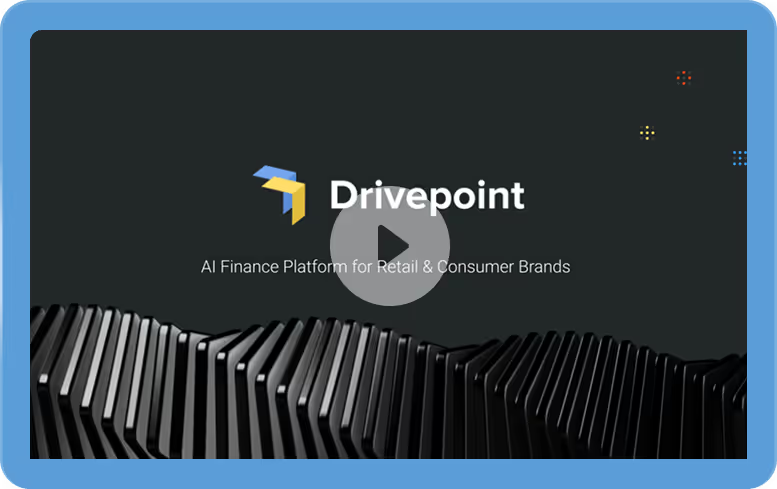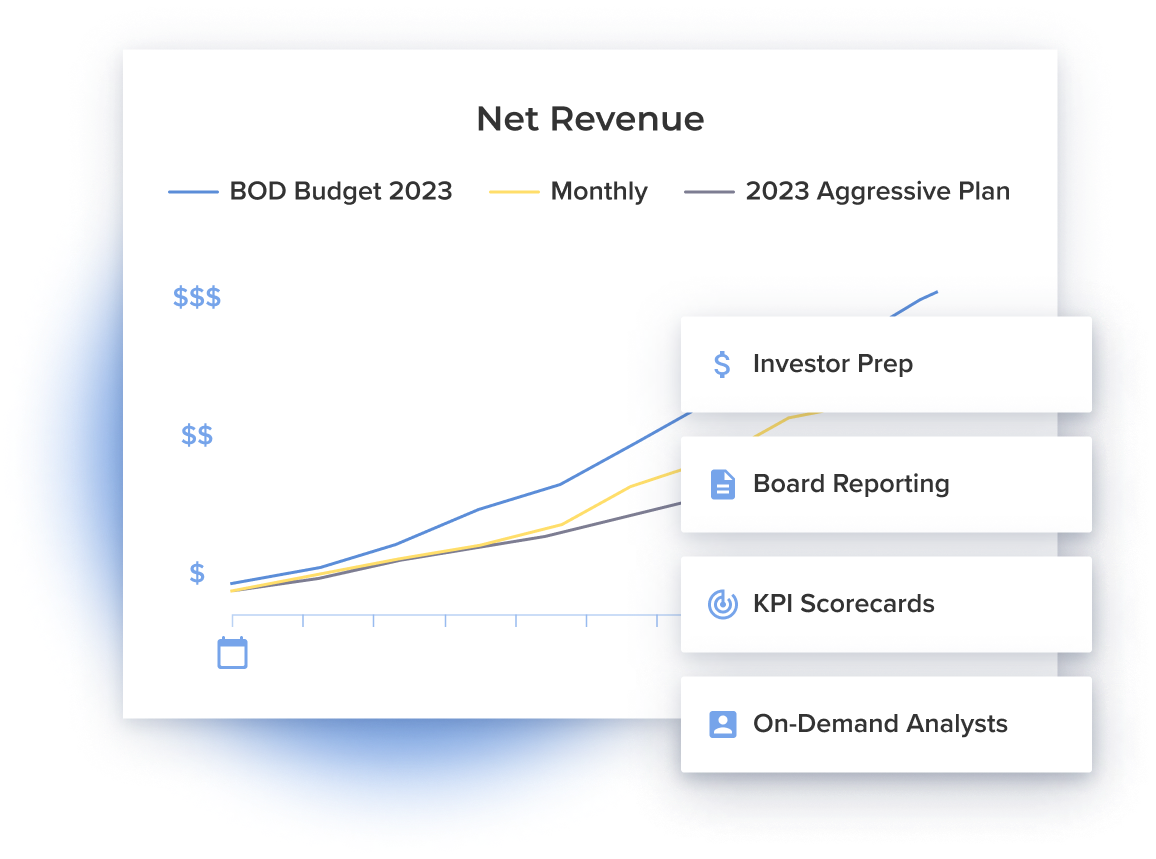Competing financial priorities can make it tough for growth-stage DTC brands to scale. One department needs more capital for growth initiatives. Another says the organization must immediately mitigate risk (or else). Meanwhile, the financial statements say cost-cutting efforts should take precedence.
With all that competition for funds, you must consider each department’s case and weigh the potential ROI of each opportunity. Making the wrong choice could impede growth, or worse, stifle cash flow. To make effective decisions, you need cross-functional, collaborative finance — or, as we like to call it, strategic finance.
We recently sat down with Matt Weiler, founder of Second Star Ventures and interim CEO of Wells Group, to discuss how cross-functional planning empowers more informed, reliable financial decisions. As CFO for brands like Glossier and Daily Harvest, Matt turned the rising stars into industry heavyweights with these four actionable strategies.
1. Decide between tangible growth and buzz
“You want to create the right buzz and marketing hype around what you're doing to create that brand halo but also not lose sight of the fact that there needs to be an ROI on that.”
Finance leaders and CEOs at growing DTC brands need to balance investments that drive measurable ROI in the near term with activities whose impact is hard to quantify but are still highly valuable in the long run. Matt says the idea is to invest in both kinds of outcomes, so you’re seeing results throughout the growth stage.
For instance, when expanding into untapped sales channels, like Amazon and big box retailers, new audiences are highly valuable growth levers. But the visibility created by expanding your online footprint also strengthens current customer relationships. Unfortunately, the impact of these relationships can be difficult to measure, leaving finance teams with little to no support for budget decisions.
To help quantify intangible results, Matt suggests collaborating with different teams to align on their needs. This will help you determine the best course of action while keeping an eye on something you can measure: net profits per initiative. For instance, he produces reports that everyday readers from any department can understand, in formats that they prefer to receive — so no one is stuck spending hours making raw data useful to non-finance departments.
Strategic finance in action
While Matt was at Glossier, the brand opened its first retail experience in New York. Buzz-creating touches were everywhere. Sales reps wore jumpsuits and called themselves editors. Six-foot versions of the brand’s products decorated the space. “All the windows, even the one at the storefront, were frosted pink; dozens of incandescent bulbs were placed strategically around mirrors and hidden in ceiling nooks, to ensure the best lighting possible for soft-lit selfies,” wrote one visitor.
This was just one example of Glossier’s larger focus on community building through experiential retail that aimed to foster customer loyalty and drive repeat business. Other initiatives during his tenure included:
- Bi-coastal flagships: After the success of its flagship New York store, Glossier opened another Instagram-worthy retail location in Los Angeles.
- Pop-up shops: To expand on its brick-and-mortar success, Glossier hosted pop-up shops with immersive brand experiences, including a takeover of Boston’s Seaport retail village and what can only be described as a cottagecore lover’s dream in Seattle.
- Experiential marketing: Capitalizing on their success with pop-ups and permanent retail locations, the beauty brand partnered with Rhea’s Cafe in San Francisco for a month-long takeover, transforming the eatery with Glossier branding and product displays.
And behind the scenes, Matt’s team pursued the brand’s long-term goal: growth. In addition to its original NYC and LA locations, today, Glossier touts storefronts in Atlanta, Boston, Brooklyn, Chicago, DC, Las Vegas, London, Philadelphia, and Seattle.


2. Assess decision risk based on measurability, probability, and reversibility
“I always ask myself, ‘Is this decision reversible? Can I measure its outcomes?’ This applies to every business activity, whether it’s a new investment or how we communicate with our customers.”
Every business activity — from vendor selection to new marketing campaigns — comes with risk. Matt evaluates these risks using a well-recognized visual exercise, where assumptions are mapped out based on how likely something is to happen and how easily you can measure it.

A future event (i.e., an assumption) that can be easily measured and is highly likely to take precedence when deciding where to allocate funds for an offensive or defensive move
To tailor the risk matrix to each unique brand, Matt takes this tried-and-true strategy one step further: he weighs how easily the decision can be reversed if the program doesn’t pan out. Then, he only moves forward on a worthwhile initiative if the cost of failure is bearable.
“If the decision has a measurable cost to it, then I know the worst-case scenario if we get it wrong,” he says. “If we feel like we are approaching a failure point, then we can completely reverse course and take the hit.”
Envision a brand awareness campaign. It’s notoriously difficult to track because it focuses on long-term brand recognition rather than immediate, measurable actions like sales or sign-ups. In this case, the brand awareness campaign isn’t a poor decision — it’s just harder to prove success. And that’s worth considering when deciding which efforts to pursue.
Of course, when all departments lay down their hand of cards — as is the case with strategic finance — assumptions can be quickly quantified and documented, making it easier to determine reversibility as well.
Strategic finance in action
Like Glossier, you can easily invest in a special event like a flagship store opening without much risk to the bottom line. But at the other end of the spectrum, it’s a lot more costly to reverse investments that affect customer perception — such as a full rebrand — which if done poorly can kill value and dilute your brand’s impact.
So, instead of funding new (riskier) initiatives after a high growth period, Glossier invested in the asset that fueled their meteoric rise: distinctive branding. (They even trademarked their signature “millennial pink” packaging in 2020.)

Let’s look at the potential impact of a new customer loyalty program. Say you collaborate with your customer success team and begin tracking repeat purchases and customer retention, only to find the new loyalty program is not hitting its milestones. You can reroute funds to acquisition campaigns — and focus on prospects who show more loyalty markers early on.
3. Prepare for success by building strong customer connections
“The last thing you want is to lose momentum because you can’t serve your customers.”
Failure isn’t limited to initiatives that fumble or flop, however; it can take many forms. Matt points out that failure can also happen when your plan works perfectly, but you’re unprepared for its success due to operational inefficiencies.
For instance, a wildly successful product launch is a major win for any DTC brand. But if you don’t have enough stock on hand to meet demand, you’re not just missing out on sales; you’re eroding trust with your customers, AKA, the biggest long-term asset.
That’s why Matt believes finance departments should be just as invested in the customer experience as the rest of the company. Strategic finance can protect that asset and prioritize the brand’s connection to the customer.
But initial budgets and scenarios rarely serve customers well. After all, these financial planning exercises are for the business’s benefit, not the customer.
That’s why you need to work with other areas of the business. For instance:
- Ask the product development team what they’ve uncovered in recent feedback to involve customers in the development process.
- Upgrade supply chain and QC software to include data collection that supports continually improved shipping, unboxing, and reverse logistics experiences.
- Prompt customer service teams to create campaigns that collect immediate and actionable feedback loops which can then inform future marketing work.
- Have talent recruiters focus on candidates who demonstrate customer-centric attitudes through all divisions and ranks.
Once you’ve aligned with other departments on how to handle explosive growth, then the final step is just execution. During regular budget reviews, you’ll see if and where the business is underperforming. In these cases, Matt determines which investments create high customer value. He asks himself two questions:
- Is ROI satisfactory?
- Is there enough time to generate higher ROI?
From there he can pivot slightly — or hold steady. If the business is exceeding expectations, Matt doubles down on the investments fueling that growth.
Strategic finance in action
Within four years of launching, Glossier went from a beauty blog to a unicorn company, partly by breaking from traditional growth tracks. CEO Emily Weiss launched the brand from her blog, Into the Gloss, which pioneered major beauty and style trends, including dark brows, dewy skin, “no makeup” makeup, and millennial pink.
The blog’s huge social media following gave Glossier instant free buzz. With the money saved on brand awareness marketing, finance was free to allocate earnings to paid media channels, product development, and brick-and-mortar expansion.
Source: Instagram
During Matt’s tenure, Glossier grew the brand across multiple channels. So, no matter where customers encountered their content, it was guaranteed to reinforce branding and drive engagement.
- Social media: Instagram became the brand’s bread and butter, growing to 1.5 million followers by 2018. To do this, they shared engaging, non-salesy content and were quick to respond to customer questions.
- Influencer marketing: Glossier partnered with ~500 superfans — mostly micro-influencers and regular customers — who were given promo codes and a monetary incentive to share those codes. CEO Emily Rice summed up this strategy in a 2019 interview: “Every single person is an influencer.”
- Customer experience: Their website and retail stores focus on user-friendly displays and navigation. Their content relies heavily on personalized product recommendations and social proof. And it all reinforces their philosophy: skin first, makeup second.

In contrast, food and beverage brand Daily Harvest didn’t change its core product, but instead, expanded its offerings by listening to customers and catering to their values. Today they offer more than 60 products, earning $250M in revenue in just five years.
4. Pay back your CAC more quickly while balancing LTV
“Tracking your LTV, CAC, and payback periods helps you keep a finger on customer growth at all times. If you can’t pay back your CAC, you can’t drive ROI.”
Of course, you still need to justify any investment you make, regardless of risk. If an activity requires too many resources to drive positive ROI, it might be better to make changes or postpone it. A clear way to ensure positive ROI, Matt says, is to evaluate how LTV and payback periods affect CAC for every investment.
Looking at three specific metrics over time will help you understand whether your customer acquisition efforts are fruitful:
- Customer Lifetime Value (LTV): Traditional LTV-improvement tactics focus on prompting repeat or referral business, but another way you can improve your customers’ LTV is by lowering your CAC and shortening the time it takes to pay back those costs.
- Customer acquisition cost (CAC): If LTV is a value creation lever, then CAC is your cost-cutting metric — the other key to profitability.
- Payback period: Longer payback periods typically require high LTV to offset your CAC. Short payback periods mean faster returns which you can reinvest to grow your capital more quickly. Over time, those reinvestments accumulate into better net profits than if you allow paybacks to lag.
Strategic finance in action
Consider Daily Harvest’s aggressive approach to ad spend. Under Matt’s leadership, the brand decided to go all-in on multiple channels and focus on near-term ROAS and shortening CAC payback periods.
Balancing CAC, payback periods, and LTV can give you the bandwidth — and funds — to tackle other revenue drivers. For instance, Matt worked with other internal teams to lead the brand’s fundraising efforts, eventually closing $100M in capital to achieve unicorn status.
Matt also united teams for strategic finance at Glossier, where leaders focused on empowering their retail locations to build the kind of customer loyalty that other brands ogle and envy. With strategic finance, they have the confidence that their customers’ LTV is worth the higher cost of a luxury retail experience.

Drivepoint creates a flywheel for cross-functional strategic finance
Strategically allocating your resources starts with evaluating the potential impact of every investment. For Matt, the best way to create accurate forecasts is by using Drivepoint.
Drivepoint creates a flywheel for your business by turning financial and customer data into actionable insights that support your cross-functional finance decisions. With Drivepoint as your strategic finance platform, you can:
- Create and compare financial scenarios for informed decision-making with ease
- Build accurate forecasts across all sales channels in minutes
- Sync sales, accounting, and marketing data to holistically understand your business
Want to see how Drivepoint helps you build a winning financial strategy for every team? Book a demo today.











